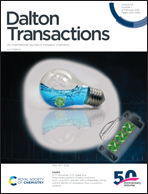Cadmium and manganese hypophosphite perovskites templated by formamidinium cations: dielectric, optical and magnetic properties†
Abstract
The recently discovered hypophosphite perovskites are promising functional materials. This contribution is devoted to the structural, thermal, dielectric, Raman and optical studies of a new hybrid organic–inorganic perovskite, [FA]Cd(H2POO)3 (FA = formamidinium, NH2CHNH2+). We also report the thermal, magnetic, dielectric and optical properties of the known perovskite [FA]Mn(H2POO)3. [FA]Cd(H2POO)3 crystallizes in a monoclinic structure, with the space group C2/c, and transforms at 190 K to another monoclinic structure, with the space group P21/n. For both compounds, the FA+ is disordered through the two-fold axis in the high-temperature (HT) phases. However, lowering of the temperature of [FA]Mn(H2POO)3 results in the complete ordering of FA+, while the organic cations still occupy two positions in [FA]Cd(H2POO)3. Raman data provide strong evidence that both FA+ cations have the same or a very similar structure and that the phase transition is triggered by an ordering of the FA+ cations. The dielectric studies confirm the order–disorder nature of the phase transition and reveal the presence of two dipolar relaxations observed in the 320–220 K range and near the phase transition temperature. The low-temperature (LT) process exhibits the classical Arrhenius-type behaviour, whereas the behaviour of the HT relaxation suggests glass-like behaviour. Magnetic studies show that [FA]Mn(H2POO)3 is an example of a canted antiferromagnet with a low ordering temperature of 2.4 K. Diffuse reflectance studies show that the Mn (Cd) hypophosphite is a wide bandgap material with Eg = 5.20 eV (5.42 eV). Upon ultraviolet excitation (266 nm), [FA]Mn(H2POO)3 exhibits reddish-orange emission at 656 nm associated with the 4T1g(G) → 6A1g(S) transition of octahedrally coordinated Mn2+ ions. [FA]Cd(H2POO)3 shows significantly weaker purplish-blue emission at low temperatures composed of two bands at 425 and 443 nm, which are almost completely quenched at 160 K. For both compounds, CIE chromaticity coordinates show negligible change with temperature. Furthermore, the intensity of the observed emissions decreases quickly with increasing temperature, suggesting the possible application of [FA]Mn(H2POO)3 in non-contact optical thermometry.



 Please wait while we load your content...
Please wait while we load your content...